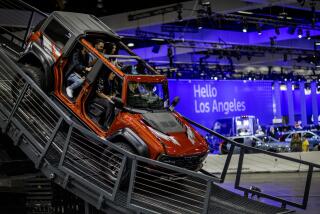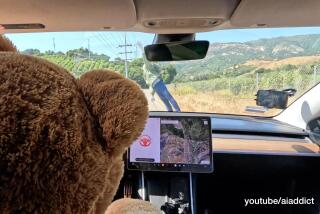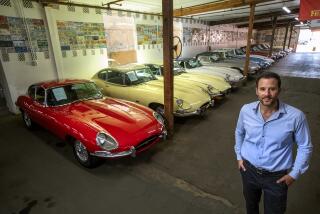Test Drives Never Tasted Like This Before
- Share via
The live flowers and flickering candles in the portable restrooms were a sure sign that this wasn’t your typical automobile showroom. Same for the golf pro using a video camera and a computer program to dissect the swing of a prospective car buyer.
Guests of Toyota Motor Sales USA’s Lexus Division who gathered on two recent Saturday afternoons at the former Tustin Marine Corps Air Station in Orange County watched chefs from Campanile and La Brea Bakery prepare gourmet food and grooved to the sounds of Latin jazzman Poncho Sanchez.
What they didn’t do was suffer through a hard sell. Lexus spent $1 million to construct a huge hospitality tent and driving courses where consumers put Lexus vehicles and competing luxury cars to the test. But the only sales pitch came at the end when guests were asked if they wanted to be contacted by a Lexus dealer.
The upscale event is the latest iteration of what auto insiders call a ride and drive, which car companies have long used to get consumers behind the wheel. Now the marketing tools are evolving into lifestyle fairs where food, music and entertainment can be as important as the test drives.
As car companies engage in a heated battle of the brands, the test drives can serve as powerful marketing tools that create a halo effect for their car lines--though, as the absence of salesmen indicates--they seldom result in immediate sales.
Gregory P. Kitzens, national marketing manager for Torrance-based Lexus, said consumers are “buying into an organization, not just buying a machine or a piece of metal. We’re trying to give them an indication of how they can expect to be treated as Lexus customers.”
It’s the same formula being dished up by Mercedes-Benz, which invited Ray Charles to perform for potential customers recently when it introduced a new line. Rock band Dishwalla will be on stage in August when Volkswagen of America Inc. turns keys to its cars over to younger consumers at a Long Island park where race car driver Danny Sullivan will give lessons. Hyundai Motor America Inc. last year tried to connect with young male consumers by incorporating a ride-and-drive program into a nationwide three-on-three basketball tournament.
“These are highly targeted events, and if [auto companies] target you correctly, then they’ve got you,” said Jim Mateyka, a vice president with consulting firm A.T. Kearney Inc.’s Southfield, Mich.-based automotive practice. “Car companies are trying to develop sophisticated one-on-one marketing relationships. The ultimate goal is to know everything you like and want to do.”
Potential road hazards abound. Competitors suggest that Mercedes’ new line was upstaged by Charles. And observers note that VW might alienate older consumers who don’t know Dishwalla from dishwater. And then there’s the very real risk that consumers may fall for a competitor’s vehicle.
There’s long been speculation in the auto industry that competitors’ models are tinkered with to make the host’s vehicles appear all the hotter. At the Lexus event, for example, several drivers complained about a loud noise in the back of a Lincoln Navigator.
Lexus representatives said the company had nothing to do with the noise. Gordon Wangers, managing partner of Vista-based Automotive Marketing Consultants Inc., which staged the Lexus affairs, says today’s drivers are too sophisticated to be fooled: “These cars are right out of the showroom--and that’s a fact.”
As is usually the case with a party, the ultimate arbiter of success is the guest list. That means stocking the event with bona fide customers whose automotive tastes and pocketbooks match the cars on display.
Although 25% of Lexus’ guests had recently visited a Lexus showroom, the majority came from a joint marketing venture with Conde Nast Inc. The publisher of such upscale titles as Gourmet and Vogue culled names of subscribers who own cars manufactured by Lexus’ competitors.
“We told [Lexus] that we know more about your customers than you do,” said Conde Nast Executive Vice President Catherine Viscardi Johnston. “And we told them we know where your next customer is going to come from.”
The auto world’s move toward relationship marketing is driven in part by the realization that traditional advertising isn’t delivering sufficient showroom traffic, observers say. Manufacturers also realize that not everyone who’s watching flashy commercials on television is shopping for a car.
In contrast, 2,500 invited guests at the Lexus events in Orange County were signaling their interest in buying a new car. Just as Lexus executives hoped, it had the desired effect with some attendees.
“They made us feel welcome, which is important,” said Alta Loma resident Linda Sobiecki, who drives a Corvette but is in the market for a new car. There was no salesman in the back seat when Sobiecki pushed down on the gas pedal of a Lexus SC 400 and raced through the orange safety pylons. “Nothing drives me away faster than someone trying to sell me something,” she said.
Guests might not have felt so comfortable had they known that their moves were being monitored by a sophisticated scanning system that uses bar codes on guest badges. According to Lexus, the average guest stayed almost three hours, enough time to take about four test drives.
Manufacturers know from experience that ride-and-drive sessions can improve a brand’s image. General Motors Corp. surveys completed in the wake of a program last year showed that 85% of guests left with a higher opinion of GM cars. “These events are, in effect, the ultimate focus group,” GM spokesman Donn Walker said.
For Lexus, a company already known for building technically solid cars, the goal is to persuade loyal BMW, Mercedes-Benz and Jaguar drivers that Lexus vehicles are as sexy as they are solid. “We’re trying to get them to buy into this brand,” Kitzens said. “We want them to believe that it stands for something.”
More to Read
Inside the business of entertainment
The Wide Shot brings you news, analysis and insights on everything from streaming wars to production — and what it all means for the future.
You may occasionally receive promotional content from the Los Angeles Times.










